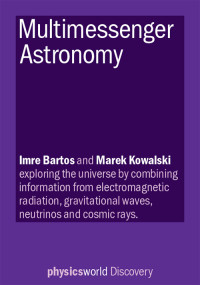 By Margaret Harris
By Margaret Harris
Immediately after last year’s announcement that the Laser Interferometer Gravitational-Wave Observatory (LIGO) had seen its first gravitational waves, a lot of the discussion centred on what the discovery meant for general relativity. This was understandable: getting further confirmation of Einstein’s century-old theory was (and is) a big deal. But in the longer term, and as the LIGO detectors notch up a few more observations (they’re currently crunching data on six new candidates), the emphasis will shift away from the waves themselves, and towards what they can tell us about the universe.
The key thing to realize here is that gravitational waves are fundamentally different from other, better-studied cosmic “messengers” that travel to Earth from distant reaches of the universe. Unlike photons, gravitational waves are not impeded by clouds of gas or dust; unlike cosmic rays, they are not deflected by electromagnetic fields. In addition, some of the most dramatic astrophysical events, such as the merger of two black holes in empty space, are “dark” or “silent” to other messengers: these events produce gravitational waves in copious quantities, but not, as far as we know, anything else.
So the prospect of using gravitational waves to study astrophysical phenomena is tremendously exciting – but gravitational waves aren’t the only new messengers in town. A few years before the LIGO breakthrough, a team of scientists working on the IceCube neutrino detector in Antarctica observed some novel signals of their own: neutrinos with energies so high that they could not have come from the Sun or other local sources. The trajectories of these “cosmic” neutrinos are also unaffected by gas, dust or electromagnetic fields. And they, too, are thought to be produced by astrophysical processes that remain poorly understood.
These two discoveries – cosmic neutrinos in 2013, and gravitational waves in 2015/16 – represent the beginning of “multimessenger astronomy”: exploring the universe by combining information from electromagnetic radiation, gravitational waves, neutrinos and cosmic rays. So far, this field is in its infancy, but as detectors continue to improve, and collaborations develop better ways of sharing their data, it is sure to become more important.
If you’d like to learn more about this fascinating topic, you should take a look at the latest ebook in the Physics World Discovery series. Multimessenger Astronomy is co-authored by a gravitational-wave expert (Imre Bartos) and a neutrino astronomer (Marek Kowalski), and is available free in ePub, Kindle and PDF formats. Like all of the books in the series, it offers an accessible introduction to the field for anyone – from students to senior researchers – who wants to get to grips with an exciting and important “hot topic” in physics.
Guidelines
Show/hide formatting guidelines
this text was deletedwhere people live in harmony with nature and animals</q>
Some text